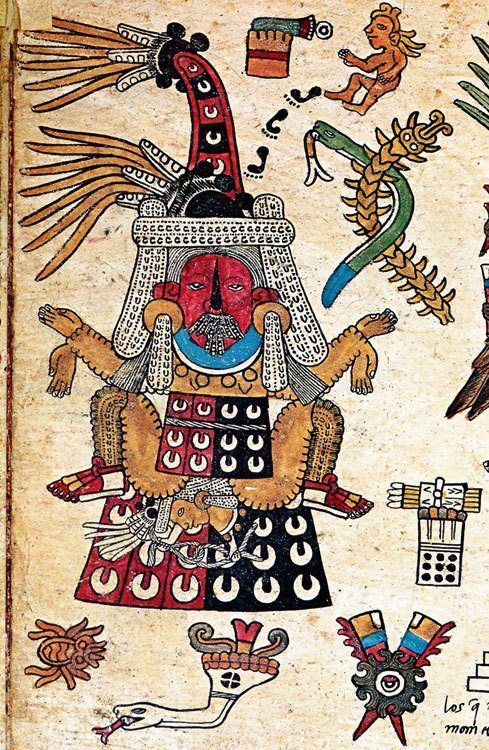Molly Bassett is an enthusiastic advocate for studying Mesoamerican religion, a welcome new direction in Religious Studies. She credits the critical mentorship of David Carrasco, Neil L. Rudenstine Professor of Latin America Studies at the Harvard Divinity School. Although she does not mention this, his influence makes her an intellectual “granddaughter” of Mircea Eliade, who was Carrasco’s principal advisor at the University of Chicago and to whom Carrasco has paid special homage in Waiting for the Dawn: Mircea Eliade in Perspective (Carrasco and Law 2009). Mostly due to a dearth of qualified teachers, interpretation of Mesoamerican religions has been undertaken by individuals with little or no formal training in religious studies. As a result, many have made their way into this field via an autodidactic approach. On the upside, Bassett emphasizes how Mesoamerican studies push scholars to be interdisciplinary. Her work on the rich Florentine Codex, the Codex Mexicanus, and other 16th century sources builds on prior work by art historians such as Diana Magaloni (a student of Mary Miller at Yale) as well as linguists, ethnohistorians, paleographers, and archaeologists.
Bassett rightly notes the preconceptions and prejudices that students typically bring to studies of the Aztecs, among them notions of human sacrifice (which, given divine reciprocity, might be better understood as “human gifting”), cannibalism (or anthropophagy, both actual and metaphorical), and other forms of ambiguous violence. These have been the subject of a brilliant essay, “Ethics and Ethnocentricity in Interpretation and Critique: Challenges to the Anthropology of Corporeality and Death,” by archaeologist Arthur Demarest (Vanderbilt) in The Taking and Displaying of Human Body Parts as Trophies by Amerindians (Chacon & Dye 2008). He outlines radically different conceptions of blood and bodies among Spanish and Aztecs, noting, for example, that Spanish horror at Aztec rituals was shaped by specific Christian beliefs about the sanctity of the blood and body of Christ, human mortality and corporality, ethnocentric perceptions that condition Western consciousness even today. For the Aztecs, flaying humans and wearing their skin inside-out (as was done with the Culhua princess) represented a profoundly different conception of personhood and corporality. Just as a hardcore vegetarian, vegan, or animal rights activist might recoil at a supermarket meat counter or a leather goods shop, Spanish reactions to Aztec practices were conditioned by distinctly non-universal values and beliefs. As Demarest writes, “Neither ethnocentric revulsion nor ethnocentric purification can substitute for elucidating, as best we can, the nature and meaning of the beliefs and practices of other societies.”
From another perspective, recent scholarship on Mesoamerican religions has been influenced by Mircea Eliade in a persistent fashion that has yet to be critically addressed. For example, discussions of Olmec and Maya religious art and iconography refer routinely to concepts of an axis mundi, a tripartite cosmology, “shamanism,” and archetypes of the World Tree and Cosmic Mountain that come directly from Eliade’s work. However, these often lack direct citations, much less critical analyses based on the history and context of Eliade’s ideas (an example of this would be the 1993 book Maya Cosmos, by Friedel, Schele, and Parker, but a pervasive use of these concepts persists to the present). These and related concepts are often taken for granted by art historians, but their tacit acceptance merits a closer analysis by scholars in Religious Studies, who may be prepared to evaluate the influence of Eliade on fields of study other than their own and to offer alternative models. One recent work relevant to Bassett’s research as well as interdisciplinary methodology is Wearing Culture: Dress and Regalia in Early Mesoamerican and Central America (Orr and Looper 2014), which considers cultures much earlier than the Aztecs, ones contemporary with early Judaism and Christianity, but lacks a Religious Studies approach.
Mesoamericanists and other specialists in pre-Hispanic cultures of Latin America often question Kirchhoff’s original 1943 model of “Mesoamerica” and its utility for understanding broader interaction in the southern U.S., Caribbean basin, southern Central America, and northern South America. Interestingly, in the same article, Kirchhoff also proposed the notion of a “Chibchan” area to the south, one that has now become even more relevant given recent announcements of the “discovery” of a “lost city” or “vanished civilization” in non-Mesoamerican eastern Honduras. Yes, Mesoamerican religion is a fascinating and stimulating area for more Religious Studies scholarship, but I’m sure Bassett would enthusiastically agree that this extends to approaches to religion throughout the Americas. She says, “Puritans pale by comparison to Aztecs,” but they also pale in comparison to Mayas, Chibchas, Taínos, Moches, Tiwanakus, Incas, and many, many others. It would be nice to think that her work is just the beginning of a Renaissance of sorts in the study of indigenous American religions and their deep and complex intersections with Christian, New Age, and other contemporary practices. For example, the rich variety of New Religious Movements (NRMs) in Latin America and the U.S. that assert neo-Aztec, Maya, and other Mesoamerican identities call for evaluation on their own terms.
Xipe Totec (“Our Lord the Flayed One”) wears the flayed skin of a sacrificial victim. “Wearing people’s skins” is powerful imagery, tied to how we understand them by putting “skins” (such as “religion”) on them.
Bassett’s emphasis on questions and methodological toolkits is especially valuable. These should include theoretical toolkits specific to Religious Studies. Mesoamerican religion is fertile ground for a host of new approaches that go well beyond traditional (Eliadean) comparative studies. Public fascination with “ancient” civilizations of Mexico (including ones such as the Aztecs that are no more ancient than Leonardo da Vinci) derive from Romantic notions that can be traced to myths of Lost Tribes and lost continents, recurrent tropes in traditions from Mormons to New Age traditions that have sought to both “other” and to mistakenly identify Native peoples. A detailed knowledge of the history of Mesoamerican studies, both scholarly and vernacular, as well as contemporary scholarship by archaeologists, art historians, and ethnohistorians is essential for approaching these. Bassett refers to how Aztecs may have sought to dress Cortes in order to treat him as a “god”. We must consider the adornments with which we dress pre-Hispanic indigenous religion in special skins in order to make it comprehensible to us. Of course, this includes even the manufactured skin of “religion” itself.



